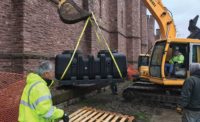Commercial plumbing products are more connected than ever, offering remote monitoring and data collection that opens the door for predictive analytics. The newest commercial boilers demonstrate those advantages, with controls that provide information access via mobile apps and websites.
“People want to know immediately when something is going wrong with their boiler and what they can do to prepare to service it,” Raypak Commercial Product Manager Peachie Maher Hytowitz says. “We are providing notifications of issues or preventative maintenance needs, the location of the issue and possible solutions and information to aid in preparing to solve the issue, such as what parts may be needed. Maintenance personnel do not want to have to go down to a boiler room to troubleshoot the system, come back up, order parts, wait for parts to arrive, and then go back down to the boiler room. They want solutions that do not require multiple visits to the site to save their resources and time.”
“We also have customers with multiple sites where visiting every single boiler to gage what’s going on is a time-consuming process. Having one mobile platform where you can view the status and control all the units under your management is useful.”
Raypak launched its Raymote app and website this spring to address this market need. The mobile version provides real-time performance info, such as vent temperature, flow rates, inlet and outlet temperature, and offers remote system adjustment and control. The web-based version offers more in-depth historical data for site analysis. Both offer notifications of preventative maintenance and service needs.
“If you have been having issues with your system, you can now access all of that historical site data,” she says, “which allows you to have increased visibility to how your system is actually operating. It gives you more tools to tune your system for optimal performance and to troubleshoot the boiler and the system.”
Hytowitz sees the plumbing industry, like all mechanical and manufacturing industries, progressing rapidly in this direction. In the near future, pumps and other heating components will likely also be connected, with the ability to communicate and provide performance data to the user. For now, she adds, a connected boiler can provide a process-of-elimination point to identify what is malfunctioning in a heating system.
“Everyone is looking at the potential of offering this kind of connectivity, and I think in the future we will be capturing data from all of that componentry,” she says.
Organizing and sorting this wealth of data could help plumbing engineers learn from previous systems and improve future designs.
“You will have the potential to look at the data and make better recommendations for installation or operating parameters,” she says.
The advancement of component-specific connectivity and data accessibility can provide benefits for those without a BMS to collect and present data gathered by a boiler’s controls. Even those with a robust BMS can find it helpful to receive product-specific notifications rather than whole-building notifications.
With the potential for all this data collection, the challenge will be devising the best ways to sort it and make it actionable.
“I think predictive maintenance is going to be standard demand in the near future,” Hytowitz says. “If users can be notified in advance that a failure may be eminent, they can prepare for it and make adjustments. That has the potential to save a lot of time and money. I think there will also be a drive toward hubbing the data collection in a manner similar to BMS so that a user can look at the boiler and the total building ecosystem to drive predictive maintenance to the whole building.”




